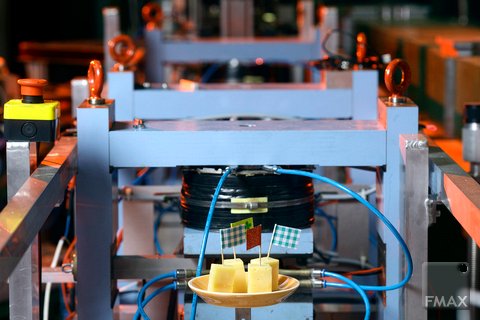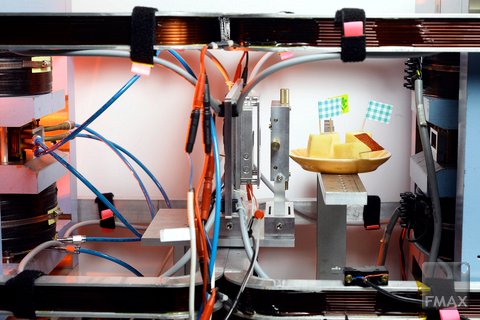Nuclear scientists and food researchers will gather at the Reactor Institute Delft this weekend to discuss how neutrons can reveal the hidden properties of food.
The crispy freshness of bread, the formation of yoghurt, the structure of cheese or the anatomy of candy bars. Such are the topics that will be discussed by the unusual amalgam of scientists and corporate researchers who will gather at the Neutrons and Food workshop held at the TU’s reactor institute, starting this weekend (Sunday 29 January to Wednesday 1 February). Co-organiser Dr Wim Bouwman (Applied Sciences) is excited that nine of the 55 participants are from industry (Mars, Unilever and Nestlé to name a few). “These people have practical questions. With our neutron facility, we may set up collective research programmes.” Bouwman organised the workshop together with food science expert, Professor Erik van der Linden, from Wageningen University.
It turns out neutrons are very well-suited for revealing new knowledge about food. For one, neutrons interact nicely with hydrogen atoms. In the food context, this provides a measure for the degree of saturation of fatty acids, the crispiness of bread’s crust or of sugar entering a solution. The other advantage is that neutrons are sensitive for structures that range from nanometres (read: molecules) up to tens of micrometers – the size of microstructures in food. “Unlike a microscope, a neutron beam will measure the average properties of a macroscopic quantity of food,” explains Bouwman.
In order to measure such properties, the neutrons, originating from the nuclear reactor’s active core, need some sophisticated manipulation. That’s what happens in the 5-meter long ‘Sesans’ set-up. First, the neutrons are polarised: only neutrons with a specific direction of spin can pass. A set of two electromagnets then separates the neutrons based on their spin state (up or down). Incidentally, quantum mechanics allows neutrons to possess both spin states at the same time. The separated neutron spin states then pass through a food sample, after which another set of electromagnets reunites the spin states just before they hit the neutron detector. Sesans stands for Spin-Echo Small-Angle Neutron Scattering.
In absence of a sample, the bundle will be just as polarised as in the beginning and nothing much can be seen. If however one of the neutron spin states is more delayed by the passage through (for example) fat globules than the others, a loss in polarisation will occur. This polarisation, measured by the neutron detector, reflects the sample’s inner structures. By varying the strength of the magnetic fields, it may be tuned from nanometres up to 20 micrometres. No images spring from these measurements – just graphs whose peaks and troughs provide researchers with intriguing clues of the underlying biochemical processes.
Take yoghurt making, for instance. Traditionally, it’s known that one needs to add lactic acid producing bacteria to milk in order to make milk proteins clot. Food technologist Sofie Ossowski, from the University of Lund (Sweden), has ‘neutronised’ various steps in the yoghurt-making process. She established that at first 0.3 micrometer aggregates form, which after acidification grow into 10-micrometre lumps. She also discovered that whey helps stabilise the larger aggregates, which translates into a better preservation of the product.
“You can watch the process occurring,” says Bouwman. “In yoghurt you can see 0.1 micrometer protein clots lumping into 5 micrometer chunks.” Such protein or fat lumps typically occur in dairy products, sauces, mayonnaise and peanut butter. The coagulate size seems indicative of the freshness, which is another line of research: Which treatments result in longer shelf lives and increased freshness.
As for the upcoming workshop, Bouwman hopes to convince food research and industry representatives of neutrons’ potential for improving the understanding of the biochemical processes in food production. Now who would have thought that neutrons could actually be good for you?
http:// www.neutronfood.nl
Many of the churches and cathedrals in south-western Netherlands were built with white Belgian sandy limestone, which was mainly imported during the 14th and 15th centuries. Nowadays, however, only the occasional lump of this limestone is found as a by-product of sand mining. Meanwhile, the old churches erode, their extended parts, like statues and tympana, especially so, and need to be repaired or replaced. But with what?
Sandstone cannot be used because of a law (Zandsteenbesluit, 1951) prohibiting the use of this stone, as it poses a health hazard to workers. Sandstone’s fine dust, created when the stone is being processed, is said to cause silicosis, or ‘dust lungs’.
As a PhD student, Dr Wido Quist (33), of the faculty of Architecture, researched the selection process for restoration materials in four historic buildings over long periods of time – the entire 20th century. Dr Quist wanted to know the reasons why specific materials had been chosen; however, often there was no documentation available about the choices of materials. Moreover, it seemed that external circumstances had dictated the choices, such as, for example, when supply routes were cut off during the First World War, or a building contractor simply preferring to use up his old supplies first. In later years, the choices often seemed to be based on fashion or faith in the claimed quality of a stone, like its durability. Nowadays, it’s mostly Portland limestone, imported from the UK, that’s being used. However, when the Portland is used to complete a structure originally made from Bentheimer sandstone, the Portland sticks out against the grey and weathered Bentheimer like a sore thumb.
Dr Quist argues that the restoration architect is responsible for the choice of materials, and that choosing the materials shouldn’t be a matter of taste or convention. Instead, he argues, one should make explicit choices about colour, texture, historic unity, aesthetics and durability. A simple table in his PhD thesis should make this decision-making process more transparent.
Wido Quist, ‘Vervanging van witte Belgische steen – Materiaalkeuze bij restauratie’, 14 February 2011, PhD supervisor Professor Rob van Hees.





Comments are closed.